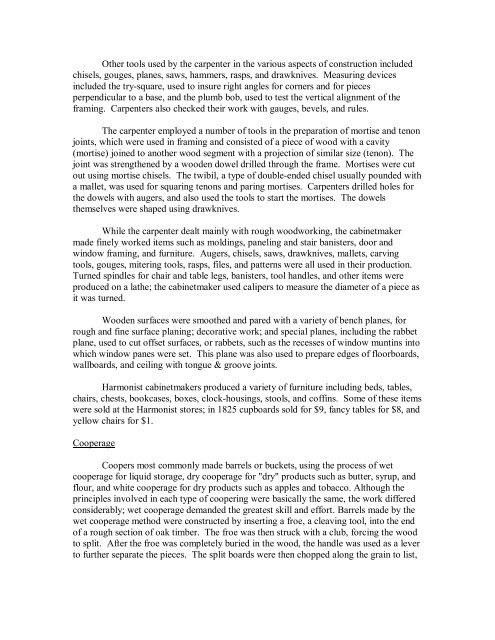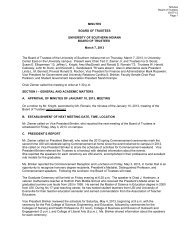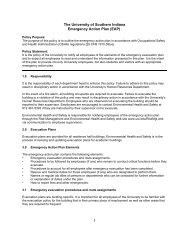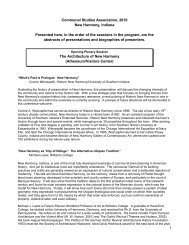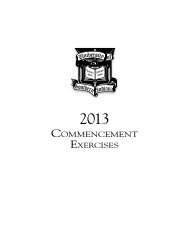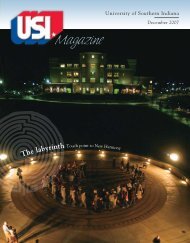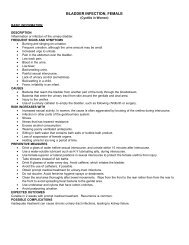The Harmonie Society - University of Southern Indiana
The Harmonie Society - University of Southern Indiana
The Harmonie Society - University of Southern Indiana
Create successful ePaper yourself
Turn your PDF publications into a flip-book with our unique Google optimized e-Paper software.
Other tools used by the carpenter in the various aspects <strong>of</strong> construction included<br />
chisels, gouges, planes, saws, hammers, rasps, and drawknives. Measuring devices<br />
included the trysquare, used to insure right angles for corners and for pieces<br />
perpendicular to a base, and the plumb bob, used to test the vertical alignment <strong>of</strong> the<br />
framing. Carpenters also checked their work with gauges, bevels, and rules.<br />
<strong>The</strong> carpenter employed a number <strong>of</strong> tools in the preparation <strong>of</strong> mortise and tenon<br />
joints, which were used in framing and consisted <strong>of</strong> a piece <strong>of</strong> wood with a cavity<br />
(mortise) joined to another wood segment with a projection <strong>of</strong> similar size (tenon). <strong>The</strong><br />
joint was strengthened by a wooden dowel drilled through the frame. Mortises were cut<br />
out using mortise chisels. <strong>The</strong> twibil, a type <strong>of</strong> doubleended chisel usually pounded with<br />
a mallet, was used for squaring tenons and paring mortises. Carpenters drilled holes for<br />
the dowels with augers, and also used the tools to start the mortises. <strong>The</strong> dowels<br />
themselves were shaped using drawknives.<br />
While the carpenter dealt mainly with rough woodworking, the cabinetmaker<br />
made finely worked items such as moldings, paneling and stair banisters, door and<br />
window framing, and furniture. Augers, chisels, saws, drawknives, mallets, carving<br />
tools, gouges, mitering tools, rasps, files, and patterns were all used in their production.<br />
Turned spindles for chair and table legs, banisters, tool handles, and other items were<br />
produced on a lathe; the cabinetmaker used calipers to measure the diameter <strong>of</strong> a piece as<br />
it was turned.<br />
Wooden surfaces were smoothed and pared with a variety <strong>of</strong> bench planes, for<br />
rough and fine surface planing; decorative work; and special planes, including the rabbet<br />
plane, used to cut <strong>of</strong>fset surfaces, or rabbets, such as the recesses <strong>of</strong> window muntins into<br />
which window panes were set. This plane was also used to prepare edges <strong>of</strong> floorboards,<br />
wallboards, and ceiling with tongue & groove joints.<br />
Harmonist cabinetmakers produced a variety <strong>of</strong> furniture including beds, tables,<br />
chairs, chests, bookcases, boxes, clockhousings, stools, and c<strong>of</strong>fins. Some <strong>of</strong> these items<br />
were sold at the Harmonist stores; in 1825 cupboards sold for $9, fancy tables for $8, and<br />
yellow chairs for $1.<br />
Cooperage<br />
Coopers most commonly made barrels or buckets, using the process <strong>of</strong> wet<br />
cooperage for liquid storage, dry cooperage for "dry" products such as butter, syrup, and<br />
flour, and white cooperage for dry products such as apples and tobacco. Although the<br />
principles involved in each type <strong>of</strong> coopering were basically the same, the work differed<br />
considerably; wet cooperage demanded the greatest skill and effort. Barrels made by the<br />
wet cooperage method were constructed by inserting a froe, a cleaving tool, into the end<br />
<strong>of</strong> a rough section <strong>of</strong> oak timber. <strong>The</strong> froe was then struck with a club, forcing the wood<br />
to split. After the froe was completely buried in the wood, the handle was used as a lever<br />
to further separate the pieces. <strong>The</strong> split boards were then chopped along the grain to list,


